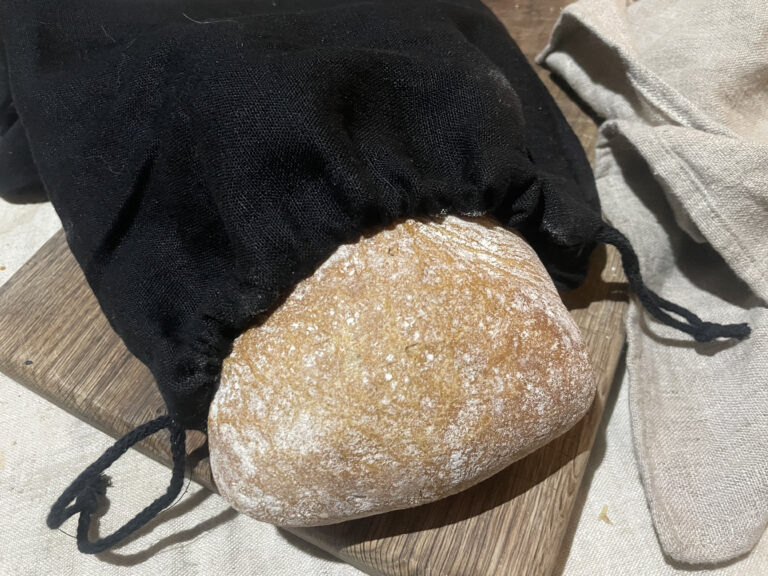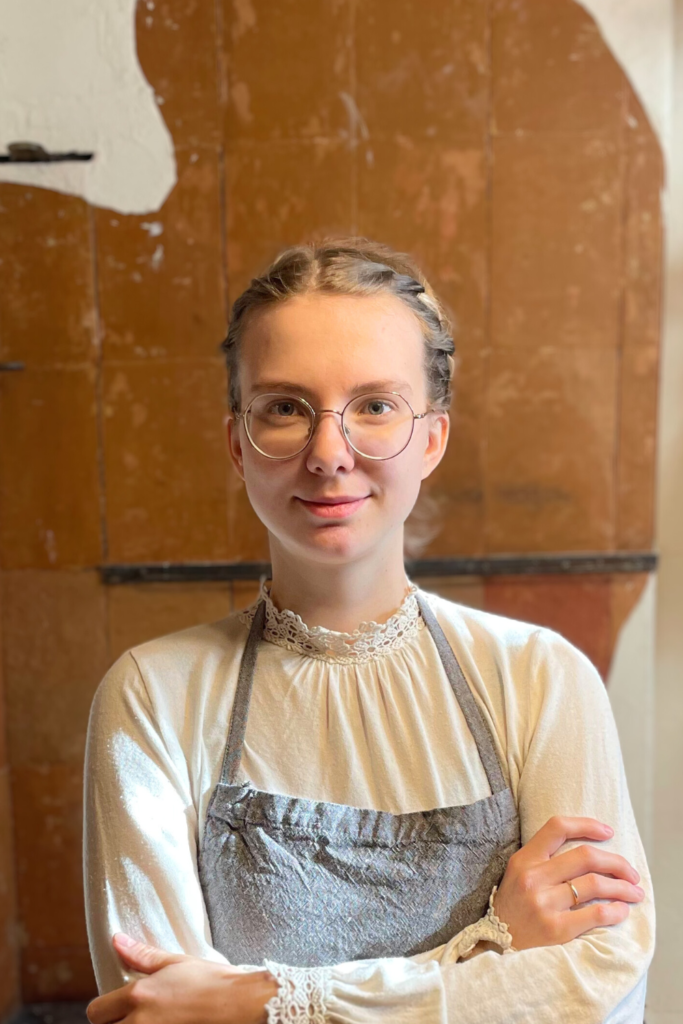There are several ways to make hems and even a hem technique can be a little bit different. I always use the same methods in sewing that I also write about in this post. There are even more ways to hem, but since my goal is always to do things as simply as possible, I’d like to stick to just a limited selection for now. Here you can learn how to make a curved double hem (for example, on round objects), I’ll show a couple of different methods for making a straight hem, and I’ll also include instructions for hemming corners to ensure a neat finish without creating a bulky pile of multiple fabric layers.

Before starting, come and follow me on Instagram, Facebook, and Pinterest!
What is a hem?
Shortly it’s a way to transform the raw edge of the fabric into the clean edge. Although everyone has likely seen hems on the clothes they wear, not everyone may know that the name for this sewing technique is a hem. A hem is one of the most basic ways to conceal the frayed raw edge of the fabric. For example, look at a skirt or a pair of pants. The bottom edge is probably “rolled up”. That finishing technique is called a hem, and I’ll explain how you can successfully make a hem yourself.
What you’ll need for hemming
Sewing machine
Fabric/garment
Thread
Scissors
Double Fold Hem / Rolled Hem
A double-fold hem is the most typical and should be used especially in places where the fabric edge is visible from both sides. For example, when making kitchen towels or curtains.
You can do a double-turn hem as well as several other stitches by ironing or even basting, but it’s quicker to do it while sewing with a machine. I usually sew it directly because it’s often faster. However, thoroughness plays an important role in many situations, so I’m now writing down a detailed guide, and then everyone can adapt and shorten the guide according to their skills or preferences.
- Place the right side of the garment on the table or floor. Sew the hem on the wrong side of the garment.
- Fold at least half an inch of garment fabric inwards and press the hem allowance with an iron.
- Now choose how wide you want the hem to be (usually 0.2 to 0.8 inches). Make a second fold and press again.
- If you wish, you can make a basting stitch or even pin the fabric together, but it’s not necessary to waste time on it.
- Sew the hem of the garment close to the folded edge.

Single Fold Hem with Overlock
A single-fold hem is much easier to make than a double-fold, but it may not have as many uses because the overlock stitch will be visible from the wrong side of your fabric. However, the best way for a single-fold hem, is, for example, on pant leg, where the wrong side is unlikely to be seen when worn.
First, you don’t necessarily need an overlock machine to make this stitch! The overlock stitch can be replaced with a regular zigzag stitch or, ideally, with a stitch similar to an overlock stitch, like the SS23 stitch on a Brother sewing machine. The latter-mentioned stitch is very stable and works just as well as an overlock, it just doesn’t look as professional, but since this stitch is on the wrong side anyway, it doesn’t matter, does it?
- Sew the raw edge with an overlock, overlock-like, or zigzag stitch.
- Fold the sewn edge to the wrong side of the fabric and sew the edge down with a straight stitch.
- The single-fold hem is ready. It may not be as visually appealing, but it saves time, is easier to sew, and saves a bit of fabric. Not in significant quantities, but in some situations where fabric is scarce or incorrectly measured, it can be a “life-saving” option.

Curved Double Hem
A curved hem is necessary when sewing, for example, a round tablecloth or circular skirts. Often, a hem on a curved edge tends to twist, and the fabric starts to stretch during sewing. For this, you need to make a simple additional seam, which in a sense resembles making a single-fold hem, but I’m sure you’ll figure it out during sewing!
- Sew the raw edge along the entire length about 0.2 inches away with a straight stitch. Since the fabric is circular or arched, the straight stitch helps keep the hem edge stable.
- Now fold the frayed edge twice into the fabric, as if making a double fold hem, and press with an iron. If desired, secure with pins or baste.
- Sew the hem close to the folded edges.

Mitered Hem / Corner Hem
I first felt the need for a mitered hem when I was sewing my first kitchen towel from thick, sturdy linen fabric. The corner ended up with a bulky pile of multiple layers of fabric, making it difficult, almost impossible, to sew. Since I’m not a professional seamstress—meaning, I’ve never formally learned sewing—I didn’t know what to do initially. I tried googling and searching for information on YouTube, and eventually found a very detailed tutorial on how to hem corners. Based on that guide, I’ve always used the mitered corner technique because it gives the best result and less bulk fabric. I’ll also add a link to a detailed and helpful video so you can fully understand the process. Initially, I used a regular pencil to mark lines for making corners, but now I usually do it by eye if the texture of the fabric allows it.
- Fold the fabric once from both edges of the corner, as if making a single hem, but do not sew anything together. If the fabric has two sides, fold it to the wrong side.
- Optionally, you can press with an iron, but it may not be necessary depending on the fabric.
- Now, bring the edges together so that the right side of the fabric is inside and the folded edges are outside.
- Sew the fabric together at a 45° angle, as shown in the picture.
- Trim excess fabric about 1 mm away from the seam.
- Turn the corner right side out.
- You’ve completed your beautiful mitered corner.

Hem With a Foot
You can also hem with a special hemming foot. This is a quick and convenient method, which is very useful, for example, when making a pinafore dress with very long hemmed edges. Hemming with a foot gives you the best results and allows you to make a fairly delicate, narrow, and neat hem.
Blind Hem
For certain types of fabric (such as linen or silk), you can also use a blind hem stitch, but I don’t think it’s as durable as a regular hem and I wouldn’t prefer it. Blind stitch might be a great way if you want to make a wide hem or if you are sewing dress pants. There is also a special blind hem foot for that.
You can read about the above two and several other hemming ideas in this post. I also recommend checking out interesting ideas for finishing necklines on this page.
Ideas and Tips
- Although hems are usually made on the wrong side of the work, you can make a hem on the right side as well. I’ve made a hem on the right side when sewing a dress shirt and a button placket. I made the hem on the wrong side on the buttonhole side and the right side on the buttons side – it looked pretty cool.
- Sometimes you can work faster without ironing (if you need to hem a shorter piece), but for hemming long meters and large quantities at once, it’s worth finding and heating the iron!
- For truly delicate fabrics, especially when sewing a blind hem, hand stitching the hem is an excellent option. However, hand sewing is time-consuming, and depending on the length of the hem, it might take hours and hours.
- When making the hem, always leave at least 0.6 inches of seam allowance when cutting the fabric.


How to Sew a Hem (Curved, Straight and Corner)
Here you can learn how to make a curved double hem, a straight hem and I'll also include instructions for hemming corners.
Materials
- Sewing machine
- Fabric/garment
- Thread
- Scissors





